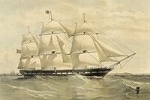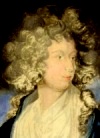This is one section of a series of essays about the people who owned the land in Gloucestershire on which our house was built. The title deeds of our house took me to the grandchildren, and the grandchildren took me into the Bay of Bengal and a Wiltshire vicarage. The links on the left help you navigate around this page, or return to the separate home pages for Families, and The Field Estate.
In the 1760s, John Calland made his money with the East India Company in Madras. By the time he was 35 he was back in England living the life of a gentleman, with sons at Westminster, a house in Mayfair, and ownership of land and coal mines in Wales. The grandchildren of his daughter Sarah inherited the land on which our house was built in the 1870s. This is the Madras part of the story.
The East India Company
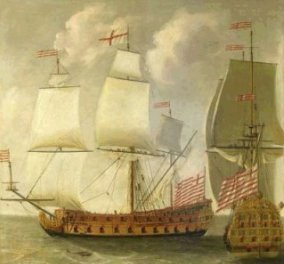
For most of the reign of Queen Elizabeth I, the East Indies trade had been dominated by the Dutch. In 1599 the Dutch East India Company announced first: that they would be trebling the price of pepper and second: that they would be buying English-built ships to expand their fleet.
The London merchants, aware that they were missing out, called a meeting chaired by the Lord Mayor. On 31 December 1600 Queen Elizabeth I signed the charter which launched 'The Company of Merchants of London Trading to the East Indies', with a monopoly on all trade east of the Cape of Good Hope.
The merchants raided their shoeboxes and put up £70,000 to fund the first trip to the spice islands of Indonesia. A condition of the monopoly was that English woollen cloth had to be taken for trade, so that went on board too. This cargo became a problem, since the cloth was not welcomed or wanted in the hot and humid spice islands. Fortunately the pioneering captain had captured a Portuguese ship laded with Indian cotton on the way, so he used this instead to trade for spices.
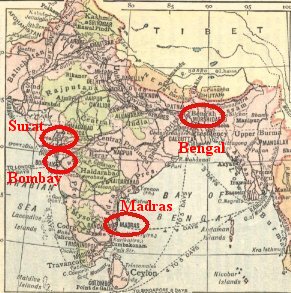
As soon as word got back to London, a separate deputation went to India to set up trading rights for the cotton to be used in future local trading. [William Hawkins was one of them and he too was an ancestor of those grandchildren I mentioned earlier]. It took a very long time. Imagine a telephone call where it takes at least five months to hear each side of the conversation ... Even though some decisions could be made locally, it was not until 1608 that the first trading post was established on India's west coast at Surat, just north of Bombay. Eventually the three main trading centres were within the military protection of Fort William in Bengal, Fort St George in the south-eastern district of Madras, and Bombay Castle, as shown on the map.
To begin with the Company rented the ships it needed and sent them off on their stately journeys - one trip out and one trip back in each year. The local Indian princes welcomed the traders. They could see good times coming and, indeed, soon involved their own ships in the trade. East India House in Leadenhall Street became the company's international headquarters. The slow but extremely lucrative business had begun. Cotton, silk, Bengal saltpetre (for munitions, usefully carried as ballast) and indigo, all from India (by 1897, the demand for indigo was so great that 7,000 square kilometers of India were dedicated to growing the source plants) and tea from China - would over the coming years fill the purpose-built East India dock.
Early voyages were made as separate ventures, each with its own share-holders and sponsors. Gradually the funding methods changed and by the 1650s the East India Company was a joint stock company and had twenty-three trading posts, locally called factories because they were headed by "factors", the Scottish name for an agent/manager. It kept its monopoly for another forty years and so had a well-established system in place when the British government finally decided to remove the monopoly and allow free trade.
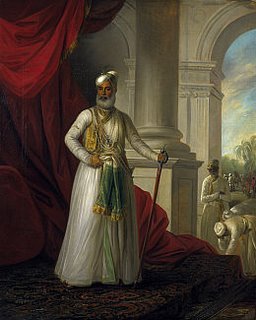
In 1717 the local Bengal ruler abolished customs duties, to the great advantage of the Company factories. Over the next century the East India Company would become one of the largest companies in the world, with a private navy, army and civil service larger than that of some small countries. In due course its import duties supplied 10% of Britain's national income. Competition from the Dutch forced the Company to abandon its spice trading in favour of high-quality cloth from India, and trading in tea from China continued only until the Company could establish its own plantations in India. London - merchants and Government alike - now had a lot depending on the continuation of trade, which was expanding to include trading en route with Africa and the Middle East. The Company had bases on St Helena and at the Cape, and its ships picked up coffee from Yemen on the way home. In 1765, when John Calland was nicely in place, there were 17,000 troops in Bengal. Fifty years later the Company's armies in India consisted of a quarter of a million men, although the vast majority were native Indians, since the cost, in transport and lives, of sending soldiers from England was prohibitively high (Colley).
18th century expansion was also happening across the Atlantic and although the East India Company was later specifically forbidden to trade in slaves, the tea they were importing was creating a huge demand for sugar, which was grown on plantations, which required slave labour. James Walvin writes entertainingly about the English passion for sweet tea and the rise in popularity of elegant tea parties, and tea drinking by manual workers. In 1700 the British imported 23,000 tons of sugar. By 1800 the import level was 245,000 tons, much of which went into tea. Tea imports, carried by the East India Company, rose from nine million pounds (lb) in the 1720s to thirty-seven million by the 1750s. So, the demand from the Carribean plantations was clearly sufficient to generate its own slave-trading companies, rather than rely on any third party. The first and largest was the Royal African Company, established in 1672 by the Stuart family with the Duke of York, brother of King Charles II, at its head. [Sorry about this little diversion, but I did wonder how much the East India Company ships might have been involved. Probably not a lot, but the Company was definitely involved in the supply of opium into China from its own production plants in India, in the late 18thC, in a government-sponsored attempt to break the Chinese restrictions on trade with the outside world. That's a long story too.]
In 1757, after a series of skirmishes - some brutal - with local Nawabs and French competitors, Major-General Robert Clive (originally a Company civil servant) orchestrated the most effective ever transaction of the East India Company by negotiating control of Calcutta and thus of Bengal and its huge treasury. Now the Company had its own men controlling the politics, its own Mint in Madras producing its own currency, its Bengal Native Army to ensure compliance, and its own well-armed fleet of Indiamen.
Clive himself, then Governor of Bengal responsible for an indigenous population of 26 million, came home in 1760. He was 35 years old. He brought with him a lifetime income of £27,000 a year from the defeated Nawab, plus £300,000 in loose change. Every Company Director in London got £24,000 as their part of the prize money.
Local Indian princes found they could fund their own debts by borrowing from the East India company men at huge rates of interest. The potential for personal gain for everyone involved in the Company was absolutely staggering. And the news was spreading. In April 1758 the East India Company's annual selection of its twenty-four Directors took place in London. This was the first meeting following the taking of Bengal, and for once there was uproar in the London newspapers, with accusations flying around and complaints of preferential treatment and good men being overlooked. One ironic correspondent was reported in the Public Advertiser on Wednesday, 5th April:
'An Impartial Query to the Proprietors of India Stock: Whether it will not be proper to add to the Oath of a Director the following Words, 'I do swear that I will not, during the Time of my being a Director, be directly or indirectly concerned in lending, to any of the East-India Company's Servants abroad, any Sum of Money at Interest, nor will I accept of any Commission or Gratuity whatsoever, for transacting any Affairs of any such Servants, and I will not, directly or indirectly, be concerned with any Person in any Combination or Agreement beforehand, to offer to the India Company any Goods, Wares or Merchandize, at any fixed Price.'
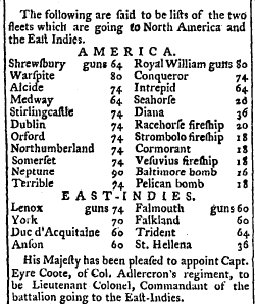
In September 1758, the Company announced [London Evening Post Thurs 5 Oct] that it was to send out its annual intake of '21 Gentlemen appointed to go abroad this Year in Quality of Writers'. These were the young trainees. Their title suggests Clerk, but these were the men who would be trained to run and manage the Companies trading contracts with the local suppliers, and with any luck get rich doing it. Since each Indiaman only made one journey each way in any one year, taking advantage of the Trade Winds, it is likely that these eager young men were accommodated in the squadron that the Universal Chronicle of 13th January 1759 announced like this:
Three of these Gentlemen were Alexander Calland, Augustus de Morgan, son of the Governor of St George Fort and John Calland's future brother-in-law, and Thomas Forbes. Alexander Calland is a mystery to me - I can't find anything more about him, although his original application is held by the British Library - but Thomas Forbes is a familiar name. The India Office database says the one on the ship was baptised in 1741 in Woodford, Essex, so he was a few years younger than John Calland. But is it a coincidence that John Calland's son Charles married the daughter of "the late Thomas Forbes" in Clifton, Bristol, in 1807? And that Thomas's son had been in the East India Company's Bengal Civil Service (his obituary gave his history and father's identity) ... the way in which the same names have cropped up whilst I was researching this family, and their regular links with the East India Company's civil or military service, make it a very tempting assumption.
Two weeks before the Universal Chronicle's announcement, on 2nd January 1759, the London Evening Post had published a letter from East-India-Company Mate John Iver to his wife in Scotland. The letter started:
'My Dear, This is to acquaint you that I am yet living. I arrived in India the 15th August 1753'.
He went on to ask her to put his letter in the News-Papers, then told of first sailing from Surat with a £200,000 cargo for Jodda in the Red Sea, then of fire on board, burnt Trowsers, shipwreck, making sails out of Moorish turbans lashed to oars, madness from thirst, landfall at Malabar, an allowance of 50 rupees a months from the English Government whilst recovering in Bombay (that took six months); more trips to Africa and Ethiopia, and back to Bombay. Then:
'I went the next Voyage with the same Captain [unnamed] to Bengal, and arrived there just as the moors came to besiege it. We fought the Ship till we could fight no longer, the Captain being killed, myself and the rest of the Mates wounded in many Places. We had on board 26 European Ladies, that fled to our Ship for Protection when the Town was taken by the Moors. You have heard, I suppose of the cruel Massacre of those that remained in the Town
[I think he must be referring to the incident where in June 1756 the Nawab of Bengal, Siraj-ud-Daulah, overwhelmed the British settlement at Calcutta and locked those he had captured in the jail of their own fort - what later became known as the Black Hole of Calcutta but which was actually an unpleasant one-night lock-in where the British prisoners panicked (Colley)].
"I cut my Cable and run down the river having three Moorish Forts to pass. The Ladies were in the Hold in safely, but most of the Lascars, or Black Sailors, were killed, and I received a shot, which took me in the Head and shattered my Skull; but Blood and Bones I tied up all together, having a Bengal Doctor on board, one Gray, a Scotsman; and having passed all the Forts to the Mouth of the River, my Wounds threw me into a Fever, and then I made this Will and power which I here inclose you.
"When I recovered I returned to Bombay, and continued in the Command of the Ship, and have made several successful voyages since; but finding my Health declining, I propose to return home in the Summer, 1759, though I need never want a Command in India, through the Interest of the Bengal Ladies, whose Lives I saved. John Iver
No doubt the eager young trainees read this with some alarm and displays of bravado. Three of the young men named in the newspaper report do not appear anywhere on the India Office's list of EIC employees - I wonder if they changed their minds and decided not to risk it? I hope that John Iver made it safely home. I also wonder whether he was the same man as John Iver, mariner, of Wapping, who having been "beyond the seas" when the 1747 Act was passed for the Relief of Insolvent Debtors, surrendered himself to the King's Bench Prison in September 1748 as a Fugitive for Debt. He must have had a very patient and long-suffering wife.
John Calland joins the Company
John Calland joined the East India Company as a Writer in 1750, at which time the Company had made a note of his date and place of birth, and of his parents' names. He was only about 16 years old and I wonder if his enthusiasm for adventure had anything to do with an auction sale heavily advertised by his father in 1747:
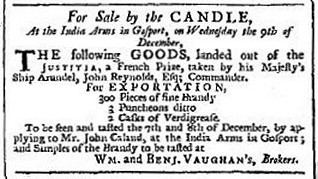
Even the name of the pub suggests a link to the trade. Maybe young John knew about the East India Company from other members of his father's family. I have only been able to discover a small part of the Calland family's earlier history, but in 1695 a London broker called John Callant complained to the Prize Commissioners about excessive duty charged by the officers of the Customs when he had bought 91 casks of French molasses at a sale by candle [a sale by candle was an auction where a pin was stuck into a lit candle and bids continued until the pin fell out - the person bidding when the pin fell got the goods. I wonder if this is the origin of "you could hear a pin drop"?]. This broker John might have been the man who baptised a son John at St Martin's in the Fields in 1705. And that son John might have been the one with goods to auction in Gosport in 1747. The only evidence I have is the various baptisms at about the right time, and the fact that it is such an unusual surname, but it would be satisfying if it were true. (Oh - and 'verdigrease'? by the cask? Apparently verdigris was used for green paint, black dye, and as a cleanser of open wounds. Much of it came from Montpelier, where grape husks were sandwiched with copper plates - and that prize ship whose cargo was being auctioned at John Calland's pub was French too.)
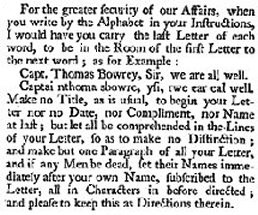
There was also a Robert Callant active with the East India Company in 1705. Or so his name was spelt in the 1749 newspaper reports of the trial of Captain Thomas Green for piracy. Mr Calland had been a supercargo - an official agent of the East India Company - and he lost all his clothes and necessaries when his ship the Worcester was seized off Scotland. He claimed £160 but got £125 from the Treasury, thanks to the affidavit of the ship's carpenter, a Mr Keagle.
At the trial it came out that Robert had also been a spy, and had been given a cypher to use when communicating with Capt Thomas Bowrey in Well-close-Square, London - with instructions not to address his reports to Capt Bowrey directly but instead to write to him care of Mr Nicholas Pople, scrivener, in Nicholas Lane, London.
Perhaps spy and commercial agent Robert was the father of the mysterious Alexander. They are both Scottish names, and there was a sizeable Calland branch in Scotland with sons at the trading and insurance desks of London. Or, since broker John baptised another son Robert, maybe he had a brother called Robert, and maybe that was the same chap. If anyone can expand this story, please email me.
In 1760 our John Calland was 27 years old, and earning an annual salary of £30 at Fort St George, Madras. Such a modest salary suggests that anyone wanting to work for the East India Company would need some form of supplementary personal income. John's father had died in 1755 and left him £100. From the general affectionate tone, in the will, towards the rest of his family, John Calland Snr (gentleman, of Alverstoke, Hants) was not too pleased that his son John had gone swanning off. His will made it clear that those who stayed home got most. Ownership of the £600 mortgage on the Red Lion Inn in Fareham, Hampshire went to his [second] wife Ann, to provide her with her own income; three houses with gardens in South Street, Gosport went to his son Robert, and his married daughter Mary got the house and gardens at Windmill Field, Gosport, where she was then living with her husband Joseph Eastwood. The will, dated 17th January 1754, goes on to say:
"Also I give and bequeath unto my son John Calland now in fforeign parts in the East Indies the sum of one hundred pounds to be paid and sent to him by my said son Robert Calland out of the one half of my personal estate as I have hereinafter given to the said Robert and with and out of the first Monies that he my said son Robert shall or may receive after my death, if he my said son John shall be then living [so no rush then, just when it happens to be convenient]. But in case I shall happen to send him my said son John the sum of one hundred pounds in my Lifetime, after the Date of this my Will, then I do hereby order and direct that my son Robert shall not be obliged or compelled to pay the Legacy so given."

I wonder if John Snr might already have funded his son to some extent, and expected to do so again. John was only 16 when he joined the company as a Writer in 1750, so maybe there had been family arguments. And at the time, the cost of a one-way ticket to India was £30 (Colley) - the same as his annual salary when he got there - so I think his father must have found at least the start-up cash for him.
In 1762, young John Calland married Elizabeth, the twice-widowed but childless 27-year-old daughter of John de Morgan, Governor of Fort St George (whose salary was £200 pa).
![Fort St George, Chennai [Madras] Fort St George](Fort_St_George_Madras.jpg)
In 1765 the local Mughal granted the Company the right to collect both local taxes and customs duties in North East India, which effectively made the Company the rulers of Bengal, India's richest province. This power spread to the EIC factories in other parts of India and helped to reinforce the general view that the British were running India.
The locally-collected money funded the purchase of Indian and Chinese commodities and took the pressure off the Company to raise its own funds back home and risk sending huge quantities of bullion by sea. You can just see the £££ registering in everyone's eyeballs. Riches were there to be made, and many took advantage. A fortunate few Company servants - deridingly being called Nabobs back home - were already returning to England with huge fortunes, some of which were based on corruption. Other fortunes were based on the sheer volume of trade, and if you could work on commission then there was good money available.
I have already mentioned Robert Callent, "supra cargo", being paid compensation for losing his clothing and equipment when the ship he was on was "seized and condemned" off Scotland in 1707. In this context, supra cargo meant an East India Co agent being taken as an additional officer on any company ship he chose. In searching for a definition of "supra cargo" I came across another East India Company story, this time about two employees - one an ordinary seaman and another a "supra cargo". In 1764 each claimed compensation from the Directors - the sailor for loss of earnings whilst in jail in China. He got £19, giving him total earnings of £80 for the period 1758-63. The agent, James Flint, had also been jailed, in Macao, then been unable to return to China "on account of the Emperor's prohibition". He got £2,000 "in consideration of his Services in China as a Supra Cargo, the Hardships he underwent in the Course thereof and his being banished from thence by the Emperor's Edict". He had already picked up a further £6,500 in commissions during the period 1760-66. Thus, while Samuel Bowen earned approximately £80 from 1758-1763, James Flint earned a minimum of £8,500 from 1760-1766.
The cost of the enterprise was running into £millions and the British Government thought it was funding a large part of it, although the decisions were still being made by the East India Company Directors along with local governors and civil servants. The ship which brought John Calland home in 1769 also brought the news (six months old) that all was not well in India, and the Company's share price dropped by 12% overnight.
By 1771 the East India Company finally and publicly announced it had a large deficit. The cost of maintaining its huge native standing army was becoming a real burden. Parliament lurched into action and Lord North's India Act of 1784 created a Board of Commissioners for the Affairs of India. The real civil servants arrived and the British Empire officially - albeit unwillingly - acquired a new territory. John Calland had gone out at just the right time, and come back - aged only 35, at just the right time. He and his family were set for life.
Greed and Corruption
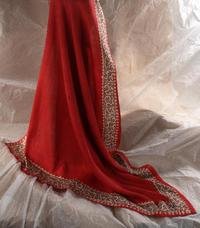
But John Calland had not come back in glory. He had gradually been promoted in the intervening ten years. In 1763, as well as becoming a father for the first time, he was Warehouse Keeper, Paymaster and Accountant at Cuddalore, 100 miles south of Madras and protected by Fort St David. Two years later he was the Senior Merchant and Head of Council there. Cuddalore region was the major supplier of the red and blue-dyed cotton which the Company exported in large quantities. In her book The View from Below, published in 2005, Kanakalatha Mukund tells the sorry story clearly:
"During the 1760s the Fort St George Council was becoming more and more dissatisfied with the cloth supplied... The fabric as well as the dye were so bad that the Council asked for an explanation. This provoked a long petition in response in which the chief merchants of Cuddalore, led by Arasappa Chetti, submitted a list of their grievances against John Calland."
It seems that John Calland had imported a lot of cotton into Cuddalore a couple of years earlier and forced several merchants to buy this cotton at 35 pagodas a candy, which was about 10% higher than the prevailing market price [5 pagodas = £1 and a candy = abt 500 lbs]. He had also insisted that Arasappy Chetti and two other merchants should become his very unwilling partners in a venture to export the rest of the cotton to Bengal by sea. He later claimed a loss of 12 pagodas per candy and adjusted this loss against the money he owed. Chetti and the two other merchants lost about 1,000 pagodas in this transaction.
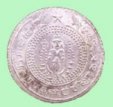
Also, when he became the Chief of Cuddalore, Calland had demanded 500 pagodas as the value of the Christmas "present" customarily given to the Chief by each locally-contracting merchant. Arasappy Chetti, the most senior merchant, offered 200, which Calland refused to accept. The high value of this "present" was more than the annual profit for some of the smaller merchants. Calland's native interpreter was heavily involved, too, and tried to put pressure on the merchants. It was not looking good for John Calland.
The Fort St George Council wanted to give Calland every chance to clear his name but were unwilling to allow his request that the merchants be asked to swear by their children (since this was, he said, their most solemn oath). The Governor made enquiries of the local merchants and head inhabitants, and was told that they had never heard of this practice. Ms Mukund infers that Calland expected the Governor to agree to his demand, causing a delay whilst the children were found and brought to the Fort, and also that the likely outcome would be that the merchants would refuse to so swear, thereby vindicating Calland. It didn't work. Governor Bourchier and the Fort St George Council concluded that the merchants had, in the main, been telling the truth. Calland was removed from his post at Cuddalore and suspended from the Company's service pending confirmation from the East India directors back in England. He was probably a bit unlucky: it is likely that the merchants would have continued trading with a less greedy Chief, and it was only the possible loss of their own contracts which made them complain. Since the merchants were too valuable to the Company's textile trade they were able to get a favourable local decision, and John Calland became the scapegoat, albeit a guilty one.
As often happens in this kind of research, facts get in the way of a good story. The family papers say John Calland returned with his family on the Indiaman Dutton,, named by other sources as having left Madras on 14th March 1769 and reported as safely off the Isle of Wight on 23rd September. But his daughter Sarah was born in Tamil Nadu [Cuddalore] on 30th May 1769 and baptised in Madras on 15th June. When the Dutton sailed, Elizabeth would have been seven months pregnant and maybe did not want to give birth on board ship. I suspect 'his family' was actually his sister-in-law and her children, who were on the same ship, as I mention later. After the birth of her son John in 1763, Elizabeth had given birth to two daughters, each called Elizabeth and both dead before their second birthday. The risk was great, whatever she chose. Over half the early British civil staff died out in India, often near the start of their appointment (Colley). Elizabeth's father the Governor of Fort St George had died in 1760 but her brother Augustus (who later died at the siege of Pondicherry) had married in July of 1768, so she still had family in Madras. I think it is likely that she stayed on until Sarah was born, then caught the next ship home, in time to get pregnant again and give birth to their son Charles, who was baptised at Gosport on 12th November 1771.
When the Dutton arrived in Bengal at the end of its outward journey in 1768, it had been in the company of another Indiaman whose passengers had had an alarming journey, described in this letter published in the St James's Chronicle of Thursday 18th May 1769, and widely copied in the English newspapers. No doubt Sarah had also heard the story.
LONDON - Extract of a Letter from Fort William, or Calcutta, dated Sept 14 1768
"I have been here about three Weeks, amidst a Profusion of Prodigality and Luxury. We are as yet in Peace in the Kingdom of Bengal, though are apprehensive of an Irruption every Day with Suja Dowla, an Indian Prince of Importance, as well as very formidable, and famous in Arms. I suppose you have heard by this Time of the War on the Coast of Coromandel, hitherto prosecuted with Advantages to the Company.
"I can't omit telling you that I never was in a Ship with such bad Navigators. We were very sickly from England, having sailed from the Downs with the Small-Pox on board, attended with a dangerous Fever, which carried off about thirty Soldiers and Sailors; besides the Misfortune of losing our Long-Boat, the Six Mate, and five able Seamen, off Joanna, one of the Commora Islands, a Place usually called at by Indian Ships for Provisions, but mistaking one Island for another, rendered us incapable of getting into any, but fortunately for us, met with the Dutton, come out of the Island the same Day, and who spared us Water and fresh Provisions, otherwise we should have been put to the Allowance of a Pint per Man a Day; but happily we had two Quarts. To compleat our Misfortunes, when we were within a Day's Sail of Madrass, and off Pondicherry, we ran foul of the Dutton about Nine at Night, being very dark, and going at the Rate of six Knots an Hour; every Soul in both Ships expected to perish instantly, and such a Scene of Confusion and Despair I never before experience. Neither of the Ships sustained any considerable Damage in Consequence of the Affair."
Also on board the returning Dutton were Mrs Donald Campbell and children. Colonel Charles Campbell - Colonel Campbell of Barbeck - had married Susanna de Morgan, another daughter of the Fort St George Governor, and they had a son Donald in 1751. If John Calland was returning to England then it seems reasonable that his sister-in-law should accompany him. Donald was later pursued by John Calland for debts incurred by his father, but this Donald would not have been old enough to have a wife and children in 1769, so that is another unsatisfactory little mystery, unless the newspaper got the name wrong. John Calland could afford to be a generous man, and he was. Generous, but not always wise. The story of his family's later life is told here.
Bibliography and interesting links
- J M W Turner's painting of the loss of the Halsewell off the coast of Dorset "The Loss of an East Indiaman" luridly illustrates the dangers
- The view from below: indigenous society, temples, and the early colonial state in Tamilnadu, 1700-1835 by Kanakalatha Mukund, published by Orient Blackswan, 2005
- The transition to a colonial economy: weavers, merchants, and kings in South India, 1720-1800 Prasannan Parthasarathi, Published by Cambridge University Press, 2001
- Captives, Britain, Empire and the World 1600-1850 by Linda Colley, published by Jonathan Cape 2002, richly researched, includes the story of a soldier's widow who, on her return to London in the 1790s, made a living cooking vegetable curries for ex-Company men and families who missed the local food, and describes in detail the later development of the Company, daily life, the fascination with tigers, and the uneasy alliance between the Company's men and the unfamiliar continent.
- Britain's Slave Empire by James Walvin, published by Tempus in 2000, is mainly about the African slave trade, but mentions the increase in tea supplied by the East India Company.
- For a short history of the East India Company, try the London Docks webpage or the British Library on-line exhibition
- For an Indian perspective of the East India Company, try here.
- The India Office has a searchable database containing the East India Company employees
- During my research I found a fascinating blog with good stories about Fort St George, and wonderful photographs
- and this website gives an early history of Fort St David, containing many names and photographs.
- Photographs of other East India Company coins are at the Chennai museum
Cuddalore today
And what of Cuddalore today? It still has some of the British buildings, but in general it is a sorry sight. Cuddalore was one of the many places on the east coast of India to suffer from the tsunami of 2004. The internet offers many links. On-line newspaper reports of the town describe hardship, water shortages, monsoon flooding, pollution from local industries and lack of employment. I browsed Google Images for Cuddalore and found PR MathiMaran's on-line series of photographs of local people and places. Please go and look for yourself.
If anyone has information which adds to, or corrects, what I have written in this essay, I would be delighted to hear from you.
